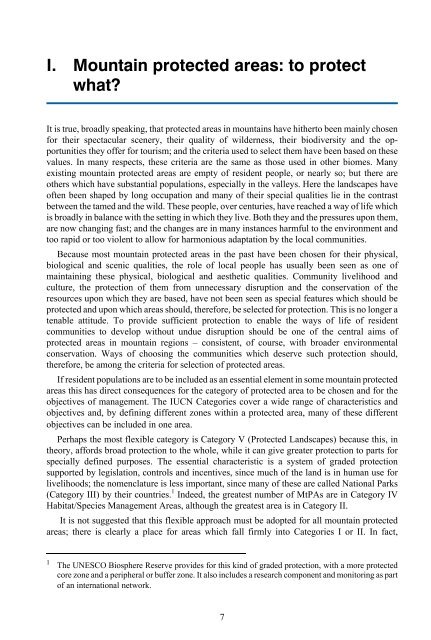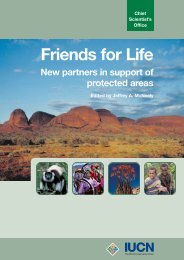Guidelines for Planning and Managing Mountain Protected Areas
Guidelines for Planning and Managing Mountain Protected Areas
Guidelines for Planning and Managing Mountain Protected Areas
- No tags were found...
Create successful ePaper yourself
Turn your PDF publications into a flip-book with our unique Google optimized e-Paper software.
I. <strong>Mountain</strong> protected areas: to protectwhat?It is true, broadly speaking, that protected areas in mountains have hitherto been mainly chosen<strong>for</strong> their spectacular scenery, their quality of wilderness, their biodiversity <strong>and</strong> the opportunitiesthey offer <strong>for</strong> tourism; <strong>and</strong> the criteria used to select them have been based on thesevalues. In many respects, these criteria are the same as those used in other biomes. Manyexisting mountain protected areas are empty of resident people, or nearly so; but there areothers which have substantial populations, especially in the valleys. Here the l<strong>and</strong>scapes haveoften been shaped by long occupation <strong>and</strong> many of their special qualities lie in the contrastbetween the tamed <strong>and</strong> the wild. These people, over centuries, have reached a way of life whichis broadly in balance with the setting in which they live. Both they <strong>and</strong> the pressures upon them,are now changing fast; <strong>and</strong> the changes are in many instances harmful to the environment <strong>and</strong>too rapid or too violent to allow <strong>for</strong> harmonious adaptation by the local communities.Because most mountain protected areas in the past have been chosen <strong>for</strong> their physical,biological <strong>and</strong> scenic qualities, the role of local people has usually been seen as one ofmaintaining these physical, biological <strong>and</strong> aesthetic qualities. Community livelihood <strong>and</strong>culture, the protection of them from unnecessary disruption <strong>and</strong> the conservation of theresources upon which they are based, have not been seen as special features which should beprotected <strong>and</strong> upon which areas should, there<strong>for</strong>e, be selected <strong>for</strong> protection. This is no longer atenable attitude. To provide sufficient protection to enable the ways of life of residentcommunities to develop without undue disruption should be one of the central aims ofprotected areas in mountain regions – consistent, of course, with broader environmentalconservation. Ways of choosing the communities which deserve such protection should,there<strong>for</strong>e, be among the criteria <strong>for</strong> selection of protected areas.If resident populations are to be included as an essential element in some mountain protectedareas this has direct consequences <strong>for</strong> the category of protected area to be chosen <strong>and</strong> <strong>for</strong> theobjectives of management. The IUCN Categories cover a wide range of characteristics <strong>and</strong>objectives <strong>and</strong>, by defining different zones within a protected area, many of these differentobjectives can be included in one area.Perhaps the most flexible category is Category V (<strong>Protected</strong> L<strong>and</strong>scapes) because this, intheory, af<strong>for</strong>ds broad protection to the whole, while it can give greater protection to parts <strong>for</strong>specially defined purposes. The essential characteristic is a system of graded protectionsupported by legislation, controls <strong>and</strong> incentives, since much of the l<strong>and</strong> is in human use <strong>for</strong>livelihoods; the nomenclature is less important, since many of these are called National Parks(Category III) by their countries. 1 Indeed, the greatest number of MtPAs are in Category IVHabitat/Species Management <strong>Areas</strong>, although the greatest area is in Category II.It is not suggested that this flexible approach must be adopted <strong>for</strong> all mountain protectedareas; there is clearly a place <strong>for</strong> areas which fall firmly into Categories I or II. In fact,1The UNESCO Biosphere Reserve provides <strong>for</strong> this kind of graded protection, with a more protectedcore zone <strong>and</strong> a peripheral or buffer zone. It also includes a research component <strong>and</strong> monitoring as partof an international network.7






